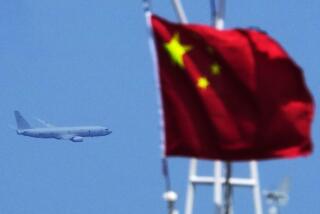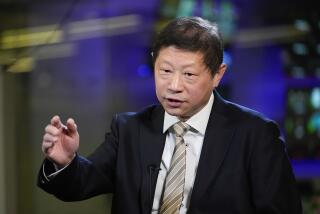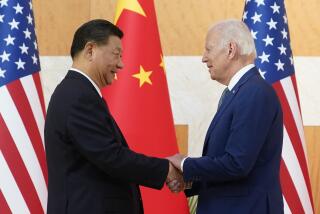COLUMN ONE : An Islamic Challenge to China : Officials fear the spread of fundamentalism in the westernmost region. They toughen controls on religious life and suppress secessionist activities.
KASHI, China — The young Uighur man glanced over his shoulder to be sure no one was listening, then spoke softly in broken English.
“The Uighurs are not happy,” he said. “The peasants, they got guns. They fought with the army. Many finished. The army--80 finished. The peasants--200 finished.”
In the dusty bazaar streets of Kashi, also known as Kashgar, Uighur hatred of Chinese authorities runs deep. Many here believe that more than 100 died fighting Chinese troops last spring in the nearby town of Baren.
Official Chinese media say 22 died in the April 5-6 clashes: six paramilitary police officers, one government official and 15 “counterrevolutionaries.” Details of what really happened cannot be confirmed.
The incident was only the latest in centuries of conflict between Turkic minorities and ethnic Chinese in China’s westernmost region of Xinjiang, a largely desert area that straddles the ancient Silk Road. But Islamic fundamentalism and the rise of ethnic nationalism in Soviet Central Asia, two factors that apparently influenced the violence in Baren, now confront the Beijing government with radical new challenges.
Authorities are responding with stepped-up controls over religious life and systematic suppression of secessionist activities.
Wang Wenheng, deputy director of Xinjiang’s Religious Affairs Bureau in the regional capital of Urumqi, said in an interview that the Baren uprising was led by an underground organization called the East Turkestan Islamic Party. It was supported by fundamentalist imams running illegal religious schools, he added.
“They want to establish an Islamic Republic of East Turkestan,” Wang said. “Their slogan is they want to fight a holy war. Some of them were trained in privately run religious schools. So we say they’re using the cloak of religion. But actually they are destroying unity between nationalities and promoting secessionism.”
The Muslims of Xinjiang are linked racially, linguistically, religiously and culturally to the peoples of Soviet Central Asia and Turkey. If the predominantly Muslim republics of the Soviet Union someday become independent, they could exert a strong attraction in places like Kashi, the key center of Uighur culture, which lies only about 100 miles from the Soviet border.
Kashi, an oasis town of mud-brick buildings and colorful bazaars, still retains an almost biblical atmosphere. Donkey carts and vendors jam the narrow streets. Tea stalls offer fresh-baked, flat Middle Eastern bread and mutton kebabs. A sprawling Sunday bazaar draws more than 30,000 people every week to a multi-acre site at the edge of town. The minarets of 108 mosques rise above the city.
Over 2,000 years, Xinjiang has repeatedly been incorporated into the Chinese empire during strong dynasties, only to break loose again. Uighurs ruled much of Central Asia from the 8th to the 12th centuries. The Kashi region and parts of what is now Soviet Central Asia were subsequently ruled by the Mongols, by the empire of Tamerlane and by the Moguls.
The Qing Dynasty re-established Chinese control in the 1700s but faced a major Muslim rebellion in the northwest part of its empire from 1862 to 1873.
Uighur, Kazakh and Mongol rebels took control of the Kashi region and declared an independent Eastern Turkestan Republic in January, 1945. Communist authorities in Beijing reasserted Chinese control after 1949. Since then, they have arranged a mass migration of ethnic Chinese from the main part of China aimed both at developing the region’s resources and ensuring that it can never again break away.
The Chinese in Xinjiang live largely separate lives. Minorities need fluency in Chinese to get good jobs, while Chinese seldom learn Uighur. Intermarriage is rare. Continuing social divisions and the long centuries of conflict ensure widespread resentment of Chinese authority.
Anger is fanned by Chinese policies ranging from controls over religion to recently tightened family planning requirements. Minorities, previously exempt from population controls, now are officially limited to two children per couple in the cities and three or four in the countryside.
Xinjiang functions like any other Chinese province, with power in the hands of officials selected by Beijing. Its formal name, however, is the Xinjiang Uighur Autonomous Region. This is in recognition of the Uighurs’ standing as the largest single ethnic group in Xinjiang; they constitute about 45% of the region’s 14 million people.
Adding other minorities, including Kazakh, Kirghiz, Uzbek, Tatar and Hui, about 60% of the region’s population is Muslim. After four decades of population transfers, ethnic Chinese make up about 36% of the population, up from 6% in 1949.
Until the early 1960s, Turkic minorities could move quite freely across the Sino-Soviet border. But then relations between Moscow and Beijing turned cold. Many families were left with relatives on both sides of the border.
Since the mid-1980s, and especially in the past two or three years, cross-border contacts have resumed.
“Going back and forth has no other purpose, it’s just to see our mothers, our little brothers,” commented Ruzeshayufu, a Uighur man leaving the town of Yining by bus to cross the nearby Soviet border and travel onward to visit his younger brother in Tashkent. “We are very happy. It’s like being born again, that’s how happy we are.”
Cross-border travel, although restricted to family reunions and trade, inevitably spreads knowledge of political and religious developments in the Soviet Union. Pilgrimages to Mecca, once banned, are now made by about 1,000 Xinjiang Muslims every year. Growing numbers of Pakistani traders, who travel by land over the Kunjirap Pass, also bring new influences.
Islamic fundamentalism in the Middle East and ethnic movements in the Soviet Union are having reverberations in Xinjiang, Wang said.
“Every year, some Xinjiang people go to Mecca on pilgrimages, and some foreigners come to Xinjiang,” Wang said. “Through this kind of contact, different sects and viewpoints invisibly spread into Xinjiang. We view this as normal and unavoidable. . . . There has been influence from some of these international tides of thinking. But as for our country, and Xinjiang, we are handling it according to our constitution and laws.”
In practice, that means a system of rigid controls.
China’s constitution, while guaranteeing freedom of religion, also guarantees what is called “freedom not to believe in religion” and grants dictatorial power to the Communist Party. Authorities try to ensure that all religious activity comes under government supervision.
The situation is not as bad as it was during the 1966-1976 Cultural Revolution, when many mosques in Xinjiang were shut down or destroyed. Throughout the 1980s, mosques gradually reopened, and people are no longer afraid to worship. But this liberalizing trend has now ended.
New restrictions published recently in the official Xinjiang Daily establish a system of government-run testing of religious leaders. All religious leaders must either hold diplomas from government-controlled religious institutions, or be tested and receive certification of their “political performance, ideological awareness and scriptural proficiency.” This testing must be done by “patriotic religious organizations” run by government religious affairs departments at the county level or higher.
No one can become a “religious professional” without obtaining a license from one of these government-controlled “patriotic religious organizations,” according to the regulations.
“Religious leaders must . . . support the Chinese Communist Party’s leadership, support the socialist system, love the People’s Republic of China, safeguard national unification and solidarity of nationalities and oppose national separatism,” the regulations say.
They must “promote simple wedding and funeral ceremonies, reform outmoded customs (and) foster new habits.”
The new rules also bar Muslim religious leaders, known as imams, from training successors outside of government-run institutions.
“Religious professionals . . . shall not operate schools or classes to teach religious scriptures or train volunteers; and they shall not . . . assume the responsibility of training religious apprentices or instill religious concepts into young people under 18,” the regulations state.
Private religious schools were formally banned two years ago, Wang said. But enforcement was uneven, and until the outbreak of fighting in Baren, many such schools continued to exist, he said, some functioning openly and others in secret.
The events in Baren “showed that the imams who run these private schools are very reactionary,” Wang said. “After the Baren incident, we were even more clear that this policy is correct: Privately run religious schools must be shut down.”
The key institution in Xinjiang for training a new generation of imams is a five-year Islamic high school in Urumqi that has about 160 students, Wang said. “This is to train relatively highly qualified Islamic religious leaders,” he said.
Government-run schools, however, cannot possibly train enough successors for all the mosques in Xinjiang, which Wang said now number 17,100.
In the past, Wang said, imams have been legally permitted to take on up to two or three youths for training as potential successors. Under the new regulations, this practice is banned.
The new rules also bar imams from accepting visits or interviews with foreigners without special permission. Permission to visit Xinjiang to report on unofficial religious and ethnic views is only occasionally granted to Beijing-based correspondents. All formal interviews must be arranged through the government.
Authorities try to use intimidation to limit casual contacts. A reporter visiting Kashi, Urumqi and Yining spotted plainclothes security agents following him. Agents twice used special cameras disguised as black briefcases. Every person who spoke of sensitive issues did so quietly and with a look of fear.
Government authorities rejected a request for an interview at Kashi’s Id Kah Mosque, the most important in all of Xinjiang, where about 7,000 worshipers attend Friday prayers every week. By luck, however, an earlier-than-scheduled arrival at the mosque found the head imam, Arunhan Aji, briefing a visiting Soviet trade delegation. Among the points he mentioned was that he and 106 other religious leaders in Kashi receive their salaries from the government.
This apparently was meant to illustrate the authorities’ goodwill. Some of the faithful, however, view things differently.
“They’ve bought our imams,” a Kashi merchant complained bitterly. “. . . We can’t trust them.”
Permission to build new mosques is rarely granted, said Wang, the religious affairs official.
“Put simply, we have enough mosques,” he said. “There’s no need to build new ones. Building new ones would add to the economic burden of the masses.”
Wang said that imams “who want to increase their own power” sometimes object to government decisions against new mosques. Such imams, he said, are dealt with through “criticism and education.”
The vast web of administrative controls over religious and social life, combined with the overwhelming power of the Chinese army, would appear to ensure that any rebellion in Xinjiang can be crushed.
Yet some of the most alarmist statements come from the government itself.
In Yining, a huge red-and-white billboard put up by the city government proclaims: “Ethnic separatism is the greatest danger facing Xinjiang.”
Ironically, that is the very message that repressive controls and most Chinese propaganda seem aimed at hiding.
So what does the future hold?
The angry young man in Kashi summed it up this way, in his whispered, broken English: “Now, trouble. Tomorrow, trouble. And again tomorrow, trouble.”
More to Read
Sign up for Essential California
The most important California stories and recommendations in your inbox every morning.
You may occasionally receive promotional content from the Los Angeles Times.










